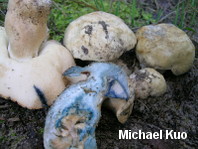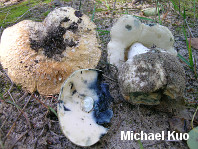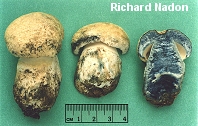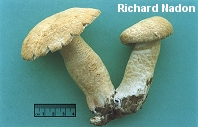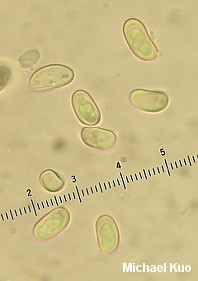| Major Groups > Boletes > Gyroporus > Gyroporus cyanescens |

|
Gyroporus cyanescens [ Basidiomycetes > Boletales > Gyroporaceae > Gyroporus . . . ] by Michael Kuo If you were to blow on it hard, Gyroporus cyanescens just might bruise blue. This easily recognized mushroom is found under hardwoods in eastern North America, usually in sandy soil (it is especially fond of grassy areas at woods' edges, road banks, and so on). Its straw yellow colors and brittle consistency, together with its strong bluing reactions and yellow spore print, separate Gyroporus cyanescens from other boletes. Like several other species of Gyroporus, Gyroporus cyanescens has a questionable relationship to trees and may not be mycorrhizal; see the comments under "Ecology," below. According to some authors, Gyroporus cyanescens var. violaceotinctus (described here, if one subscribed to the theory) differs from var. cyanescens by bruising instantly violet blue, without passing through a stage of greenish yellow. According to Bessette, Roody & Bessette (2000), a variety is collected in North Carolina that does not bruise at all. Description: Ecology: Often reported as mycorrhizal with hardwoods, but, as Singer (1945) notes, it grows "[i]n woods and even on meadows" and "does not seem regularly to form mycorrhiza, at least no preference of any forest tree is shown, and sometimes fruiting bodies are formed far from any tree at all" (see also the discussion of similar ecology for Gyroporus castaneus); growing alone, scattered, or gregariously, usually in sandy soil, especially in disturbed ground (roadbeds, path sides, and so on); summer and fall; fairly widely distributed east of the Rocky Mountains. Cap: 4-12 cm; convex, becoming broadly convex or, sometimes, nearly flat in age; dry; coarsely roughened or, sometimes, matted-scaly and hairy; straw colored or paler; bruising quickly blue. Pore Surface: White to yellowish; bruising immediately blue; 1-3 round pores per mm; tubes to 18 mm deep. Stem: 4-12 cm long; 1-3 cm thick; more or less equal, or swollen; brittle; soon hollowing; colored like the cap or slightly paler; not reticulate; textured like the cap, or nearly bald in age; bruising quickly blue. Flesh: White to pale yellow; brittle; bruising blue on exposure. Odor and Taste: Not distinctive. Chemical Reactions: Ammonia negative to pale orange on cap surface; negative to brownish on flesh. KOH negative to orange on cap surface; negative to brownish on flesh. Iron salts olive to nearly black on flesh. Spore Print: Pale yellow. Microscopic Features: Spores variable in size but mostly 8-11 x 4-5 µ (however, not infrequently as small as 6 x 3 µ and as large as 14 x 6.5 µ); smooth; ellipsoid; yellowish on KOH. Hymenial cystidia subfusiform to subclavate; thin walled; yellowish in KOH; to about 60 x 10 µ. Pileipellis a cutis of elements 10-15 µ wide; yellow in KOH. REFERENCES: (Bulliard, 1788) Quélet, 1886. (Fries, 1821; Saccardo, 1888; Coker & Beers, 1943; Singer, 1945; Snell & Dick, 1970; Smith & Thiers, 1971; Grund & Harrison, 1976; Smith, Smith & Weber, 1981; Arora, 1986; Phillips, 1991/2005; Lincoff, 1992; Both, 1993; Barron, 1999; Bessette, Roody & Bessette, 2000; Roody, 2003; McNeil, 2006; Miller & Miller, 2006; Kuo, 2007; Binion et al., 2008.) Herb. Kuo 09029402, 09149701, 09130401, 09121001. This website contains no information about the edibility or toxicity of mushrooms. |
© MushroomExpert.Com |
|
Cite this page as: Kuo, M. (2013, December). Gyroporus cyanescens. Retrieved from the MushroomExpert.Com Web site: http://www.mushroomexpert.com/gyroporus_cyanescens.html |
